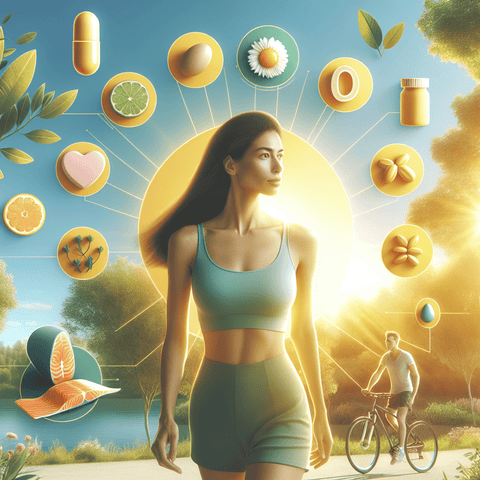Introduction
Vitamin D is an essential nutrient that plays a crucial role in maintaining overall health and well-being. Known as the “sunshine vitamin,” it assists the body in absorbing calcium, making it vital for bone health, and also supports immune function, muscle strength, and mood regulation. Despite its importance, vitamin D deficiency remains alarmingly common across the globe, especially in areas with limited sun exposure or during winter months. This deficiency can result in fatigue, weakened immunity, bone pain, and even muscle weakness, making quick replenishment vital for those experiencing symptoms or at elevated risk.
Vitamin D deficiencies can stem from several causes, including insufficient sunlight exposure, darker skin pigmentation, aging, dietary restrictions, or certain medical conditions that impair absorption. The fast-paced nature of modern lifestyles, combined with indoor living and sunscreen use, often exacerbates vitamin D insufficiency. If you’ve recently discovered low vitamin D levels or suspect a deficiency, you might be wondering how to replenish it quickly and safely. That’s where this in-depth guide comes in.
This blog outlines a comprehensive and science-backed approach to rapidly restoring vitamin D levels. We will explore the most effective supplementation options, food-based sources, and additional lifestyle strategies—such as sun exposure and physical activity—that support rapid vitamin D synthesis. We'll also provide clear guidance on dosage, timing, and how to optimize absorption with complementary nutrients. By the end, you'll be equipped with actionable knowledge to boost your vitamin D effectively and support sustained health improvements.
Choosing the Right Vitamin D Supplement for Rapid Replenishment
When it comes to quickly restoring vitamin D levels, supplements are often the most direct and efficient option. However, not all vitamin D supplements are created equal. There are two primary forms of vitamin D available in supplement form: vitamin D2 (ergocalciferol) and vitamin D3 (cholecalciferol). While both can raise vitamin D levels in the blood, research suggests that vitamin D3 is more effective and longer-lasting than D2 in maintaining adequate serum concentrations.
Vitamin D3 supplements are derived from lanolin (from sheep’s wool) or algae (a vegan source), and they work in a manner more similar to the vitamin D produced by the skin in response to sunlight. For quick replenishment, experts often recommend high-dose regimens under medical supervision. This might include daily doses of 2000 to 4000 IU, or even weekly doses up to 50,000 IU for a short period, depending on deficiency severity and advice from a healthcare provider.
When selecting a vitamin D supplement, several factors influence its effectiveness. Look for third-party tested products to ensure purity and potency. Also, consider bioavailability—the form and delivery method of vitamin D can affect absorption. For instance, vitamin D is fat-soluble, so taking it with a meal that contains healthy fats can increase its uptake. Liposomal forms or oil-based capsules might offer enhanced absorption compared to dry tablets.
Consistency is key. Set a routine to take your supplement at the same time each day, preferably with food. It’s also important to monitor your progress. Blood tests measuring 25-hydroxyvitamin D (25(OH)D) levels can help gauge the effectiveness of supplementation and guide adjustments. Be cautious not to exceed the tolerable upper intake limit (4000 IU/day for adults unless supervised), as excessive vitamin D can lead to toxicity, manifesting as calcium imbalance or kidney stones. Always consult with your healthcare provider before starting high-dose regimens, especially if you have underlying health conditions.
Combining quality, appropriate dosing, proper formulation, and consistency can make vitamin D supplementation a potent method for fast replenishment. Some premium supplement options may also include co-factors like vitamin K2 to ensure that calcium is properly utilized by the body rather than deposited in arteries—a beneficial combination for bone and cardiovascular health.
Effective Vitamin D Boost Strategies for Fast Results
While supplementation is foundational for rapid vitamin D correction, integrating it with other strategies can accelerate results. One key method is combining high-quality supplements with dietary interventions and supportive nutrients. This synergistic approach ensures that you’re not only ingesting vitamin D but also maximizing its potential through improved absorption and utilization.
Nutrition plays a dual role: it can provide direct sources of vitamin D, and it can offer nutrients that enhance vitamin D metabolism. Magnesium, for example, is essential for converting vitamin D into its active form. Without adequate magnesium, supplementation alone might not suffice. The same applies to vitamin K2, which helps direct calcium into the bones rather than soft tissues, working in tandem with vitamin D for skeletal health. Incorporating these nutrients, either through food or targeted multinutrient supplements, can significantly enhance vitamin D efficiency in the body.
Fortified foods and beverages can offer additional dietary support. Products such as vitamin D-enriched dairy (or plant-based alternatives), breakfast cereals, and orange juices are convenient ways to boost intake, especially when dietary restrictions make other sources less accessible. Pairing these fortified items with healthy fats—like avocado, nuts, or olive oil—can further increase bioavailability.
Physical activity also enhances vitamin D levels. Outdoor workouts, such as morning walks, cycling, or yoga in the park, not only expose your skin to sunlight (thus triggering vitamin D production) but also stimulate circulation and metabolic functions that support nutrient assimilation. Aim for 30 minutes of outdoor movement most days of the week for measurable impact, particularly if you couple it with sun exposure and dietary attention.
Finally, reduce factors that may inhibit vitamin D absorption. Conditions such as obesity, certain gastrointestinal disorders (like celiac or Crohn’s), and medications (e.g., glucocorticoids or anti-epileptics) can impair vitamin D metabolism. Being aware of these influences and discussing your needs with a healthcare provider can help create a targeted boost plan tailored to your physiology.
In summary, integrating supplements, strategically chosen foods, lifestyle enhancements, and synergistic nutrients creates a highly effective strategy for rapidly increasing vitamin D levels. The more comprehensive and personalized your plan, the faster the results you’re likely to see.
Quick Vitamin D Sources You Can Incorporate Immediately
Replenishing vitamin D quickly can also be approached from a dietary standpoint. While few foods naturally contain large amounts of vitamin D, incorporating those that do on a regular basis can make a meaningful difference, especially when combined with supplementation and sunlight exposure. The most potent food sources typically come from animal-based products, but options exist for all dietary preferences.
Fatty fish is the gold standard of natural dietary vitamin D. Salmon, mackerel, sardines, herrings, and tuna are particularly rich in vitamin D3. A single 100g serving of wild-caught salmon can provide between 400–1000 IU of vitamin D, depending on origin and preparation. Try incorporating grilled salmon into a salad or a sushi roll for a nutrient-dense lunch. Canned sardines or tuna also make a convenient pantry staple that provides both vitamin D and omega-3 fatty acids. For those looking for convenient supplement alternatives, omega-3 supplements with D3 can be a solid choice.
Other natural sources include egg yolks and beef liver. Eggs from pasture-raised chickens contain more vitamin D compared to conventional eggs. Try starting your day with a vegetable-rich omelet to support your D levels. Beef liver, though less commonly consumed, is nutritionally dense and provides important co-nutrients like iron and vitamin A along with vitamin D.
Fortified products offer an easy and immediate way to add vitamin D to your meals. Many manufacturers enrich milk, yogurt, plant-based alternatives (like soy, almond, and oat milk), breakfast cereals, and even snacks with vitamin D. Check the labels to ensure that these items contain cholecalciferol (D3) rather than D2, and aim for products that offer at least 100 IU per serving.
For those in search of quick and efficient culinary ideas, consider easy-to-prepare solutions like oven-baked salmon with a drizzle of olive oil (to optimize absorption), scrambled eggs with spinach, and fortified yogurt smoothies with blended bananas and chia seeds. These vitamin D-friendly meals can be prepared in under 15 minutes, meeting busy lifestyle needs without sacrificing nutritional value.
Convenient grab-and-go options are another way to top up your daily D intake. Snack bars enriched with vitamin D, fortified juices, and ready-made shakes offer last-minute solutions when you're tight on time. Optimizing your grocery haul with these items can provide steady support for daily vitamin D levels, bridging dietary gaps and reinforcing a more holistic replenishment approach.
Sunlight Exposure Tips for Rapid Vitamin D Production
Sunlight remains the most natural and efficient way for the human body to produce vitamin D, accounting for an estimated 80–90% of total vitamin D synthesis in most people. When UVB rays from the sun hit the skin, they're converted by cholesterol into vitamin D3. For those looking to replenish levels quickly, understanding how to optimize this exposure is critical.
The ideal time of day for vitamin D-producing sunlight exposure is generally mid-morning to early afternoon, ideally between 10 AM and 2 PM. During this window, the sun's UVB rays are most direct, increasing the rate of vitamin D synthesis. Aim for about 15 to 30 minutes of sun exposure on significant skin surfaces—arms, face, and legs—several times per week. Individuals with darker skin tones may require longer exposure due to higher melanin levels, which act as a natural sunscreen and can reduce vitamin D production.
Geographic location plays an important role. In regions farther from the equator, vitamin D production dramatically decreases during winter months due to the sun’s angle. In such cases, sun exposure might be insufficient, and supplementation becomes even more critical. Using tools like the D-Minder app can help you estimate optimal sun exposure time based on your location, skin type, and time of day.
While sunlight is essential, protecting your skin remains a priority. To safely boost vitamin D without risking skin damage, limit exposure time and avoid sunburns. Wearing a wide-brimmed hat and exposing only targeted skin areas can help strike a safe balance. Gradual, regular exposure is more beneficial and safer than sporadic sunbathing sessions.
To enhance your sun exposure effectiveness, schedule outdoor exercise or breaks during peak UVB hours. Combining this practice with other methods—such as taking your supplement afterward with a lunch rich in healthy fats and fortified foods—can amplify your vitamin D strategy. Reflective surfaces like sand, water, or even snow can intensify UVB availability, so be mindful of your surroundings during outdoor time.
In climates with long winters or limited sunshine, consider investing in UVB lamps that mimic natural sunlight. Though not a full replacement for sunshine, they can serve as an alternative under proper guidance and safety precautions. Remember, synergy is key. Sun exposure, combined with dietary and supplemental sources, offers the most robust path to sustained and efficient vitamin D replenishment.
Natural Vitamin D Intake Through Lifestyle Choices
Lifestyle habits heavily influence our long-term vitamin D status. Even the best diet or supplement won’t be entirely effective if your daily patterns hinder synthesis or intake. Fortunately, small but consistent lifestyle adjustments can reinforce and maintain higher levels of this essential nutrient.
Incorporating outdoor physical activity into your schedule not only boosts mood and cardiovascular health but also increases your body’s exposure to sunlight. Activities like outdoor jogging, walking your dog, gardening, or team sports encourage more sun contact while seamlessly integrating with your daily life. Commit to a few outdoor activities each week and schedule them around optimal sunlight hours for maximal benefits.
Adjusting clothing choices can also support greater UVB exposure, particularly during colder seasons. Wearing short sleeves or rolling up your pant legs while spending time outside (weather permitting) can increase skin surface area exposed to sunlight, thereby enhancing vitamin D production. Choose locations with open sky, such as parks or walking trails rather than shaded urban areas, for more efficient synthesis.
Evaluate indoor habits that could be adjusted to improve sunlight access. For example, if you work from home, consider moving your workstation closer to a window or spending your lunch break outside on sunny days. While window glass blocks UVB rays, being near bright light still helps align your circadian rhythm and promotes an active outdoor mindset.
For individuals in urban environments or high-rise buildings, weekend trips to open-air environments, such as hiking trails or countryside outings, offer an excellent opportunity for unfiltered sun exposure. Make it a habit to structure your weekends with activities that promote both physical engagement and vitamin D synthesis.
Lastly, track your progress. Monitor your symptoms, adjust daily patterns according to seasonal changes, and consider a vitamin D test every 3 to 6 months after starting a replenishment protocol. Sustaining a healthy level isn’t just about quick fixes—it’s about integrating habits that enable continuous optimization. When lifestyle, diet, supplements, and sun exposure work together, long-term vitamin D status becomes easier to maintain without reliance on sporadic interventions.
Vitamin D Supplementation Methods for Fast Replenishment
Beyond choosing the right form of vitamin D, the method of delivery can significantly influence how quickly and effectively your body absorbs and utilizes it. Today, there are various supplementation formats available, including traditional capsules, liquid drops, sublingual tablets, and even oral sprays. Each offers unique advantages depending on personal preferences and digestive health.
Capsules and softgels are the most common and convenient forms. They often come in oil-based configurations to support absorption and are easy to include in a daily routine. Liquid formulations, however, may offer faster uptake, especially for those with digestive issues that impair nutrient absorption. A few drops placed under the tongue or mixed with food can make dosing more flexible and efficient.
Sublingual tablets or sprays, designed to be absorbed directly into the bloodstream under the tongue, bypass the digestive tract entirely, potentially improving bioavailability. This form is particularly useful for individuals with malabsorption syndromes or those seeking quicker results. It’s important to follow dosage guidelines closely, regardless of the format chosen.
For rapid correction, short-term intensive loading doses may be used under medical supervision. This could involve higher daily intakes over a period of several weeks to quickly elevate blood serum levels before transitioning back to a maintenance dose. Maintenance doses (typically 1000–2000 IU/day) help to sustain levels once sufficiency is achieved.
Quality remains paramount. Look for supplements from trusted sources that specialize in purity, potency, and bioavailability. Explore curated options on Topvitamine.com’s vitamin D collection to find reliable, science-supported formats that suit your needs. Products may also include co-nutrients like magnesium or vitamin K2 for a more synergistic effect.
Always consult with a healthcare professional prior to starting high-dose supplementation, particularly for individuals with chronic health conditions or those on medications. Whether you choose oral capsules, sprays, or sublingual formats, combining supplementation with sunlight exposure and a vitamin D-rich diet offers the fastest and most sustainable path to replenishment.
Conclusion
Restoring your vitamin D levels quickly involves a holistic, science-supported approach. By strategically combining the right supplements with nutrient-rich foods, safe sunlight exposure, and lifestyle modifications, you can elevate your vitamin D levels efficiently and safely. Prioritizing high-quality vitamin D3 supplements—preferably in bioavailable forms—along with supportive nutrients like magnesium and vitamin K2, can further optimize absorption and health benefits.
Remember that quick fixes work best when integrated into a comprehensive routine that includes regular monitoring, balanced dietary choices, and exposure to natural sunlight. Personalized plans based on individual needs, habits, and health conditions are key to long-term success. Always speak with your healthcare provider before beginning any new supplementation protocol, particularly a high-dose regimen.
To support your vitamin D replenishment journey, browse through high-quality supplementation and nutritional options available from trusted sources like Topvitamine.com. Their carefully curated selection ensures that you’re getting ingredients that work synergistically to promote optimal health.
Q&A Section
Q: How fast can I raise my vitamin D levels?
A: With proper supplementation (e.g., 2000–4000 IU daily) and moderate sunlight exposure, some individuals experience improved levels within 2–4 weeks. Full normalization may take a few months depending on deficiency severity.
Q: Is vitamin D3 better than D2?
A: Yes, vitamin D3 has been shown to more effectively raise and maintain vitamin D levels in the bloodstream compared to D2.
Q: Can I get enough vitamin D from food alone?
A: It’s possible but difficult. Most people need supplements or sunlight exposure to meet their daily needs since natural food sources are limited.
Q: Should I take vitamin D with food?
A: Yes, vitamin D is fat-soluble, so taking it with a meal that contains healthy fats improves its absorption.
Q: Are there any risks with taking too much vitamin D?
A: High doses over time can lead to toxicity. Symptoms include nausea, weakness, and calcium imbalance. Always follow recommended dosages and consult your healthcare provider.
Important Keywords
- how to quickly replenish vitamin D
- vitamin D supplementation
- vitamin D3 vs D2
- sunlight for vitamin D
- foods rich in vitamin D
- fatty fish vitamin D
- vitamin D deficiency recovery
- high dose vitamin D3
- magnesium and vitamin K2 for vitamin D
- topvitamine vitamin D supplements



